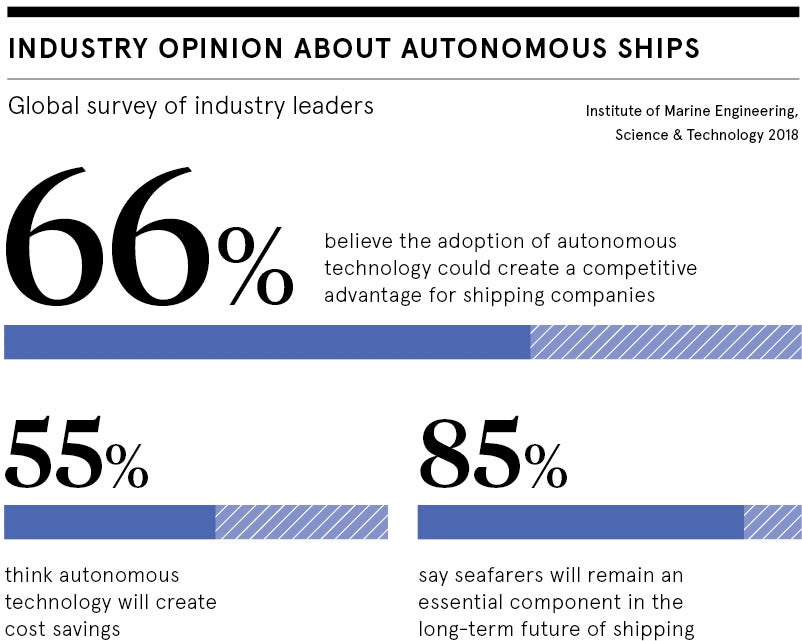By 2050 global freight demand is expected to have tripled. That’s according to this year’s ITF Transport Outlook, a biennial overview of trends in the transport sector.
Increased demand will undoubtedly lead to busier waters. With this will come heightened pressure on ports and a need to ensure that getting vessels from A to B is plain sailing.
Key to this will be technology, from driverless cranes for loading and unloading container ships to drones for inspection and repair services. And it seems the government agrees.
In January the Department for Transport (DfT) formally launched the Maritime 2050 strategy, a bold vision of what the government hopes the UK’s maritime sector will look like 30 or so years from now.
Included in Maritime 2050 are plans to transition to zero-emissions shipping and diversify the workforce. The strategy also sets out commitments to ship automation and remote operation.
Chris Grayling, the then-transport secretary, said at the time of the launch: “This strategy is a clear message to the world: we will continue to be a leading maritime nation for the next 30 years and beyond. We will be at the forefront of emerging technology and seafarer training, and will capitalise on selling this expertise to companies across the world.”
Why Maritime 2050 plans are so crucial
Although only accounting for 0.6 per cent of UK GDP and making up 1.1 per cent of UK turnover, maritime plays a crucial role in the UK economy as it facilitates 95 per cent of UK trade, including 25 per cent of energy supply and 48 per cent of food supplies, according to the DfT.
Despite this, a study by the Centre for Economics and Business Research found that the sector is also one of the most exposed to the consequences of Brexit. Given that the UK’s shipping industry is heavily reliant on labour from Eastern European countries, it could lead to higher unskilled labour costs.
While it may not be able to compete on lower labour costs, the UK can use its experience, cohesive market position and access to new technology to operate smarter, become more efficient and remain competitive, argues Kelvin Hamilton, technical consultant for collaborative research and development projects at Autodesk. The software firm was involved in the development of the world’s first 3D-printed ship propeller.
“External factors such as environmental impacts, trade disputes, movement of people and Brexit are challenging the status quo. The way businesses operate is changing, which calls for more creativity and innovation to not only remain relevant, but thrive,” says Mr Hamilton.

Making data collation a priority
So how can the UK maritime sector use technology as a competitive differentiator? According to Richard Baker, chief executive of GeoSpock, a big data company which is partnering with the Baltic Exchange to build the world’s most advanced maritime spatial database, it’s more than a case of simply investing in fully autonomous systems and equipping machinery with sensors. Only by analysing and acting on the data generated can the maritime sector then optimise supply chains, speed up processes and reduce repair times.
He argues that for value to be realised, government must prioritise data collation. Otherwise any changes brought about by Maritime 2050 are likely to fall short.
“The sector can generate huge quantities of data, from every aspect of the supply chain, from sensors in dispatch warehouses, on board ships, in ports and on trucks. However, this data can end up being siloed with no central pool that companies and the industry as a whole can utilise,” says Mr Baker.
“The government, alongside shipping and port authorities, must develop an intelligent database that captures every measurable aspect of the maritime industry. This includes metadata on location, weather, emissions, fuel usage, and journey routes and times.”
By having the infrastructure in place to measure activity accurately, government can monitor whether it’s on track to meet the objectives set out in Maritime 2050.
Fostering talent and innovation
Given the economic uncertainty surrounding Brexit, ports will undoubtedly become even more vital to the UK’s ability to trade as an island nation. Data and digital transformation present an opportunity to improve efficiencies, but to make the most of this opportunity will require the development of an ecosystem where innovation is able to flourish.
Government is aware of this and one recommendation outlined in Maritime 2050 is to develop the UK’s first smart port by 2030. It would pioneer the use of augmented and virtual reality, and also double as an innovation hub, fostering ideas and talent.
Mr Hamilton says the UK could look to the likes of Rotterdam for examples of automation in action. The Dutch city is Europe’s largest port by cargo tonnage and has ambitions of becoming the world’s smartest port. It’s also where Autodesk developed the 3D-printed ship propeller in partnership with the Rotterdam Additive Manufacturing Lab, which is based at the city’s Innovation Dock.
“In practice, the port now has the option to print ship propellers on demand, reducing waiting time for repairs and the cost of paying for spare parts to be delivered and stored locally,” adds Mr Hamilton.
Mr Baker is cautiously optimistic that the advances put forward in Maritime 2050 can be brought about successfully. He says that even though the sector has been slow to innovate in the past and make the switch from legacy systems, bringing about these changes will be vital for its sustained development.
“Artificial intelligence, blockchain and other technology all have the ability to change maritime in ways the sector may not anticipate,” he concludes. “To understand and incorporate the right technologies, the sector needs to find a way to accurately demonstrate the impact of each technology and show how it can be optimised.”
Why Maritime 2050 plans are so crucial

